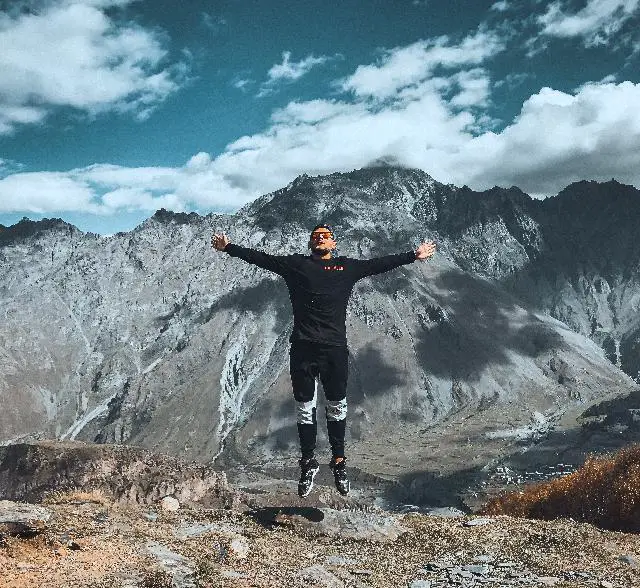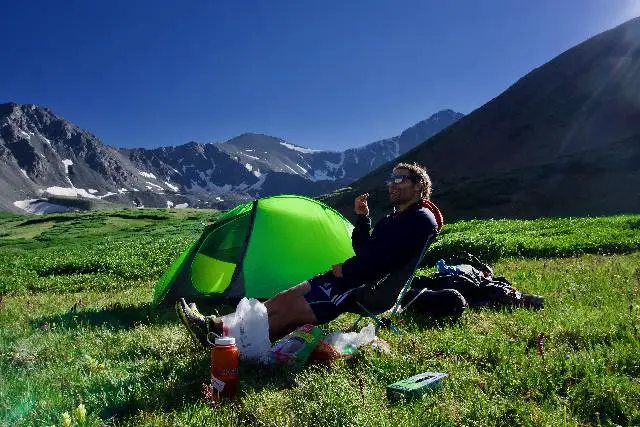Does Hiking Build Muscle: A Complete Guide [Plus Easy Tips]
Gurgling streams and leaves underfoot are great distractions from our increasingly digital lives, but where some hike for leisure, others hike as exercise.
You might wonder – does hiking build muscle?
What outward physical attributes can we gain from hiking? This guide will cover everything you need to know about the effect of hiking on muscle building. And more.
Let’s dive right in.
Does Hiking Build Muscle?
Yes, hiking builds muscle. Since hiking is walking but on challenging terrain, targeted muscles groups are legs and glutes mainly.
Did you know that it takes 200 muscles to walk one step? Not only do we engage our hamstrings and quadriceps when we lift a foot, our back muscles, calves, inner thighs and everything in between are used too.
Walking alone requires paired muscle movement of the hamstring and quadriceps to support the knees. It strengthens where your hips and thighs meet; with each heel to toe movement, your ankles are strengthened too.
Just watch the video below:

You can also expect pain along the shins after rapid walking or walking on an incline as this knee-to-shin-front muscle act as shock absorber. The right walking poles help with that, by the way.
Navigating rocky or uneven ground requires more balancing and hence more active muscle groups. Because hiking requires more side-to-side movement – the trail is rarely flat after all – it exercises mid-body muscles too.
Apart from your hips, the abdominals, oblique (waist) and back muscles are activated too. These muscles allow you to twist and turn.
When it comes to inclines and downhill movement, our glutes play a huge role as do our calf muscles.
But How is Muscle Built?
Let’s look at how muscle building works.
Of the three muscle groups in our bodies, skeletal muscles are what enable us to move. These muscles are attached to the bones by tendons.
It is important to grow these muscles for long-term mobility and overall health.
But how do we do that?
Simply put, we injure our muscle fibers to then repair them.
Muscle hypertrophy is the process where we challenge and ‘tear’ our muscles. Through high levels of resistance and weight, the fibers of our muscles sustain damage or injury. Our body then repairs the damage by fusing the fibers, causing an increase in muscle size and mass.
Throughout the recovery process, testosterone and other insulin growth hormones step in to increase protein processing, activate satellite cells, and promote muscle development.
The amount and intensity of your exercise affects the quantity of hormones released. Hiking is the perfect activity as it fulfills the three pillars of muscle-gaining exercise: challenging, consistent, and long-term.
Hiking As Exercise
Hiking is primarily an aerobic and cardiovascular activity which benefits your hearts and lungs alongside contributing to muscle growth and function.
Research suggests that people should aim for a certain amount of cardio exercise per week to build up general stamina. Strengthening muscles also decreases the risk of injury.
When it comes to cardio, there are three points to remember:
- Push yourself hard enough that you reach 70-80% of your heart rate reserve (maximum heart rate minus resting heart rate)
- Exercise consistently for at least 30 minutes
- Aim to exercise 4 – 5 days per week
Since level terrain and easy neighborhood strolls aren’t enough to overload the muscle fibers, challenge yourself with a hike every weekend.
To gain muscle from hiking, make sure you schedule consistent strenuous hikes. They don't have to be hike at an extreme altitude, but still, steep ones.
You should finish each hike with exhausted muscles. Check out these 6 tips on how to increase your strength.
Turning Hiking Into A Workout
Many folks turn towards strength training to build muscle – after all, the higher the resistance, the more muscle fiber strain that needs to occur.
Strength training in gyms often includes lifting weights, utilizing weight machines and resistance band exercises. It also covers body weight exercises like squats and push-ups.
To build muscle via hiking, incorporate strength training! Hike with heavy loads to increase resistance or challenge steeper trails. For example, if you happen to own steel toe hiking boots, wear them. They are generally bulkier and will act as added weight to your legs.
Another fun way is to use your shovel to push the snow away in case you hike in winter harsh conditions. Want it or not, that will help you strengthen your body.
One way to carry more weight is to wear ankle weights during your hike – this will increase calorie burn and muscle fiber strain. You should be careful, though. Here’s why.
However, the downsides outweigh the possible gain. While ankle weights are great additions to strength training in the gym, they may not be as suitable for walking outdoors.
If you push on to use them, make sure to start light and never do back-to-back days using them. Generally, these strap-on weights are better for targeted exercises.
Alternatively, you can wear a weighted vest.
Hanging from the shoulders and strapped in place around the waist, the vest can be tailored to your needs by adding weights to special pockets.
This is much more beneficial as there’s a more even distribution of weight over your body. The pressure also stimulates bone growth. Here are the pros and cons of this.
Because any heavy weight puts pressure on the spine, people suffering from spinal or neck problems shouldn’t use weighted vests.
Even those without noticeable problems should work with a trainer to develop a strength-training plan first.
Work your way up from the lightest wearable weight and increase slowly. At its maximum, weighted vests should not be heavier than 10% of your body weight.
One low-risk way to add equipment to your hike is to use trekking poles. Upper body exercise aside, not only do you burn 20 percent more calories, it also lessens pressure on your knees.
When strength training in a gym, you want to use heavy enough weight that you’re pushing your limits. Seasoned gym-goers will choose a weight that tires their muscles after 12 to 15 repetitions.
When it comes to hiking, however, it’s harder to calculate how much weight or resistance you need to carry. One easy factor to change instead is choosing a trail with more altitude change. Various trainers advise adjusting the intensity of the hike itself, and supplement with weight training beyond the trails.
Do consult a personal trainer or physical therapist before adding weights to your hike. Lower your risk of injury.
Recovery After Hike - 4 Important Steps
Recovery is crucial!
Without enough rest, your muscles struggle to repair. Make sure you follow the best practices for recovery or you’ll set back your fitness progress.
#1 Have A Cool-down Period
As you approach camp or the end of your hike, give yourself a cool-down period of 5 – 10 minutes.
Reduce pace so that your body can transition into a resting state, reducing risk of cramping and letting the lactic acid buildup drain away.
#2 Stretch Immediately
Help your muscles relax with a five-minute stretch! Hold each stretch for 30 seconds so the muscles can relax into their normal lengths.
Focus on your calves, hamstrings, quadriceps and hip flexors.
#3 Eat Well, Hydrate More
Food is necessary for tissue repairs. With your energy stores depleted and body raring for fuel, eat within 30 to 45 minutes of post-exercise.
Your body will absorb protein like a sponge. Water is key to recovery as well. You’ll want to be hydrating throughout your hike and well after.
#4 Rest
Let your body take care of itself. If possible, take a soak to let the heat leech away any stiffness.
To minimize any hiking soreness, you’ll want to checklist several things as well:
- Warm-up period to prep your body
- Use hiking poles to assist
- Wear properly sized backpack and ensure weight is proportional to your fitness level
- Wear proper hiking boots and socks (broken in)
- Train beforehand
Supplement With Your Diet
Apart from pushing your physical limits, you also need to manage your diet. Protein is a key component in repairing damaged muscle tissue.
Studies recommend adults consume between 46 (females) to 56 (males) grams of protein every day. Serious body builders consume much more.
Meat and eggs are well-known foods that are protein based but there are plenty of alternatives for those who don’t eat meat.
Fish is an option for those who don’t like game meat. You can also source protein from dairy, soybeans, tofu, beans and lentils, nuts and seeds.
If you’re worried about not consuming enough protein, bring some protein powder to include in your meals or make supplementary shakes with.
For those doing long sustained hikes, you’ll want to fuel up on certain kinds of carbohydrates and fats as well.
Aiming for fat burning? Skim through our guide to keto diets to read just how our food choices affect exercise results.
Conclusion
Hiking won’t give you the muscles of a bodybuilder but challenge consistently strenuous hikes and you’ll see improvement in muscle tone.
If you manage your diet carefully, muscle gains are possible too. Most importantly, understand the constraints of your body – pace yourself and give ample time for rest.
Muscle building through hiking takes time. Be patient and you’ll see results without risking injury.

Asen Stoyanchev
Founder of this website, Asen is a passionate hiker and writer who is also a gear nerd. He’s been featured on many established hiking websites where he gives hiking advice & tips. Read more about Asen here.

![Does Hiking Build Muscle: A Complete Guide [Plus Easy Tips] does hiking build muscle](https://gearuphiking.com/wp-content/uploads/2020/10/Depositphotos_98207146_s-2019.jpg)



